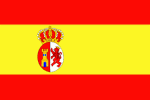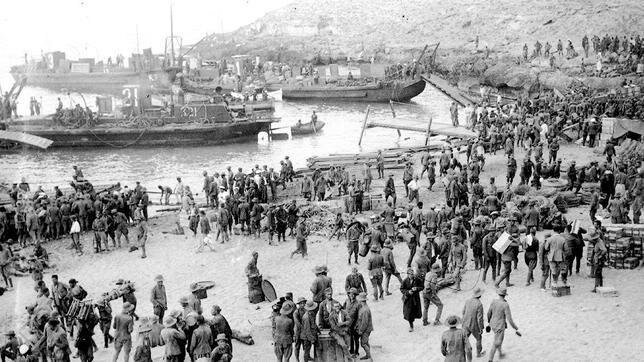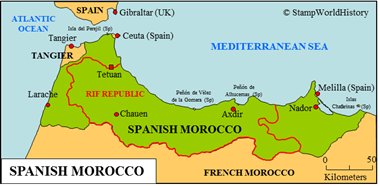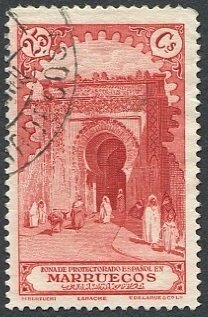
Spanish Morocco
Quick reference
General issues: Spanish protectorate 1914-1955
Country name on general issues: Marruecos
Currency: 1 Peseta = 100 Centimos 1914-1955
Population: 683 000 in 1931
Political history Spanish Morocco
Establishing the Spanish protectorate
Spanish Morocco is located in northern Africa. The local population is Berber – an Afro-Asiatic people living all across northern Africa. The Spanish have, since the late 14th and early 15th centuries, had a presence in the future Spanish Morocco – the cities of Ceuta and Melilla and a number of smaller enclaves called the ‘plazas de soberanía'[1]Literally translated: the ‘places of sovereignty’. . In 1912, the French establish a protectorate over the sultanate of Morocco. A subsequent treaty with Spain – also in 1912 – results in the partition of Morocco, whereby France gains the larger part, as French Morocco, and Spain establishes a protectorate over a zone to the north of the French protectorate and a zone to the south of the French protectorate. The former is commonly called Spanish Morocco, the latter Cape Juby. Tangier is, in the 1912 agreements, defined as an international zone. Strictly speaking, the sultan of Morocco retains the sovereignty over the country – de facto it is governed by the European powers involved.
The Spanish effectively take possession of Spanish Morocco from 1913. In the process, the Spanish are confronted with sometimes strong opposition – most notably when, in 1921, the Rif republic is proclaimed as an independent state that, at the height of its power, controls the larger part of Spanish Morocco forcing the Spanish back to their strongholds on the coast. It is not until 1926 that the Rif republic can be put down through a combined effort of the French and the Spanish.
The African Army

8 September 1925 – Spanish troops disembarking at Alhucemas
The opposition to Spanish rule leads to a substantial part of the Spanish army being stationed in Spanish Morocco – 30 000 out of a total of 100 000 Spanish army troops. Not only strong in numbers, these troops – the core of the ‘African Army’ – are, in the 1920’s and 1930’s, the most professional and effective part of the Spanish army. From 1936, they play an important part in the civil war that raged in Spain from 1936 to 1939. During the 1936 nationalist coup d’état against the republican government, the African Army supports the nationalists and Spanish Morocco is quickly secured for the nationalists – general Francisco Franco assuming command of the African Army. As the coup turns into civil war, large parts of the African Army are transferred to the Spanish mainland to play an important role in the eventual victory of the nationalists. The dictatorship, under general Franco, that followed seems to have been less oppressive in Spanish Morocco than in Spain itself.
During WWII, the Spanish occupy the international zone of Tangier – allegedly as a temporary wartime measure necessitated by a possible Italian attack on Tangier. The Spanish withdraw in 1945, upon which international administration is reestablished.
Transfer to Morocco
Morocco regained its independence in 1956, when agreements were signed resulting in the transfer of power in both French and Spanish Morocco. In the case of Spanish Morocco, without the Spanish possessions that had existed prior to the establishment of the protectorate – the cities of Ceuta and Melilla and a number of smaller enclaves. Although claimed by Morocco, these have remained Spanish until today.
Postal history Spanish Morocco
Existing postal services
Just prior to the establishment of the protectorates in 1912, the postal services in Morocco comprised offices abroad from France, Germany, Great Britain and Spain and an internal postal service known as the Sharifian post. Once the protectorate of Spanish Morocco was formed, the Spanish set up a regular postal service starting from the Spanish offices. This service gradually absorbed most of the existing services. The Sharifian post offices, all throughout Morocco, merged with the French offices in 1913 – the stamps issued by the Sharifian post being valid for use in both French and Spanish Morocco until 1915. Next, the French offices in Spanish Morocco closed in 1917. Finally, the German offices closed in 1919. The British offices in Spanish Morocco remained open throughout the existence of the protectorate until 1957. The British, from 1912, issued stamps for specific use in the offices in Spanish Morocco. Concurrent with the specific issues, the general issues for Morocco and the regular issues for Great Britain were valid for use in Spanish Morocco.
The issues for the protectorate
The first stamps for issued for the protectorate of Spanish Morocco are a set of provisionals issued in 1914 – Spanish stamps overprinted ‘Marruecos’. Further provisionals issued in subsequent years are overprinted ‘Protectorado Español en Marruecos’ and ‘Zona Protectorado Español’. A first set of definitives is issued in 1928. This set, and subsequent sets of definitives, are inscribed ‘Marruecos, (Zona) Protectorado Espanol’. Nationalist control of Spanish Morocco is reflected in 1937 issues commemorating the 1st anniversary of the nationalist coup d’etat. Stamps of Spanish Morocco have, from 1940 to 1947, been used in – occupied – Tangier. A last set of definitives is issued in 1955. The stamps of Spanish Morocco are superseded by those of independent Morocco in 1956.
Album pages
← Previous page: Spanish GuineaNext page: Spanish Sahara →



